Few things threaten to strip a wine of its elegance more than a broken cork. It’s an abrupt process: As you attempt to pull the cork from a bottle amid the anticipation of thirsty guests, it tears apart without warning, leaving a remnant stuck in the neck. This tends to happen more in older bottles due to the ravages of time, but it’s arguably more frustrating when it happens to a vintage label. When a cork morphs from a perfect, graceful cylinder to a hunk with a crumbly yet jagged top surface, it’s not a pretty sight. This sudden act of peril can cause a temporary yet jarring mood swing to your gathering — something that may be punctuated further with a curse word or two barely concealed under your breath.
If this happens — and it happens to everyone, so don’t fret too much — carefully removing the broken cork can quickly restore order and set your gathering back on its intended path. The optimal word here is “carefully,” and there is indeed a process for properly executing this impromptu rescue plan. To learn more about this process, VinePair caught up with sommelier Philippe André, private client director for Folio Fine Wines in Napa, Calif.
A Slow, Steady Process
Enjoying a bottle of wine shouldn’t be rushed, and the same can be said about removing a piece of broken cork wedged firmly in a bottle’s neck. While your first inclination may be to get the process over with as quickly as possible, André suggests slowing your roll because of cork’s delicate nature. “People forget that corks can be brittle,” André says. “If you’re removing a cork, you need to be slow and patient about pulling it out unless you want it to turn into crumbs.”
The deliberate pace of cork removal should also be accompanied by specific actions, as André explains. “The first thing you want to do is secure the cork with your wine key if you can,” he says. “You’ll then want to tilt the bottle at around a 30-degree angle and carefully drag the cork from the bottle and not try to screw it out.” If the cork shows too much resistance, running warm water on the neck for several seconds can expand the glass just enough to loosen its grip on the troublemaker.
The Tools of the Trade
A well-made wine key with a long worm (a.k.a. corkscrew) can handle cork removal in a younger wine. If the bottle is older, André recommends using an ah-so, a two-pronged wine opener that can carefully grip the cork on either side. The prongs’ asymmetrical nature allows them to effectively rock the cork up the neck and out of the bottle. Reliable versions of both tools can be cost effective, but if you have the itch to splurge, André recommends picking up The Durand, a wine key/ah-so hybrid specifically designed to uncork old wine bottles. “It’ll cost you triple digits, and the TSA doesn’t like it, but it makes you look like a master somm every time,” he says. “It’s just too damn easy to use.”
It’s also wise to prepare for the occasional failed effort. The leftover cork may fall apart during its attempted removal, especially if you’re dealing with an older label. It’s an issue that André says can be easily remedied. “If the cork crumbles into the wine, just strain the wine into a decanter,” he says. “You can always put the wine back in the bottle afterward.”
Even if the worst-case scenario happens and you find yourself collecting cork bits into a strainer, it’s not a big deal in the grand scheme of things. Broken corks happen, and your guests will understand. Besides, the frustrations of a broken cork tend to disappear after the first sip.
